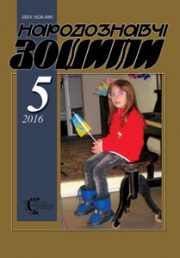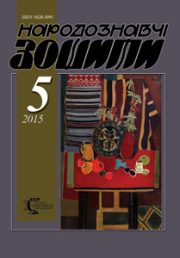The Ethnology Notebooks. 2022. № 1 (163), 152—161
UDK 821.161.2-312.3.09″191″М.Коцюбинський:[39:639](477.85/.87)
DOI https://doi.org/10.15407/nz2022.01.152
KARPENKO Andrii
- ORCID ID: http://orcid.org/0000-0002-2005-1169
- Candidate of Sciences in History,
- Ukrainian language and literature teacher,
- Secondary General Education School № 55 of the city of Lviv,
- 91, Stepana Bandery Str., 79013, Lviv, Ukraine,
- Contacts: e-mail: andriykarpenko91@ukr.net
Abstract. The study of ethnographic foundations of literary works is one of the important areas of ethnography, which is developing in many countries around the world. Such studies not only allow to assert the realistic component of works of literature, but also provide an opportunity to reproduce cultural realities in the best possible way during their film adaptations.
This already testifies to the relevance of the topic of the proposed article, the purpose of which is a comprehensive comparative characterization of ethnographisms devoted to Hutsul economic activities, from Mychailo Kotsyubynsky story «Shadows of Forgotten Ancestors» and relevant materials from Volodymyr Shukhevych’s work «Hutsulshchyna».
The object of research is M. Kotsyubynsky’s story «Shadows of Forgotten Ancestors», and the subject — the peculiarities of the writer’s image of Hutsul economic activities, in particular, its relevance to the realities of their traditional culture (which allows to establish a comparative analysis of the text with ethnographic work of V. Shukhevych).
In view of the above, the methodological basis of the study are compliance with the principle of historicism and the comparative method.
The territorial boundaries of the study cover the Galician part of the Hutsul land as an ethnographic region of Ukraine.
In conclusion, it is stated that in M. Kotsyubynsky’s story «Shadows of Forgotten Ancestors» the economic activities of the Hutsuls are reflected quite well, as they are a kind of background for the development of story lines.
The writer focused on livestock, in particular, Polonyn economy. The vast majority of the ethnographic realities mentioned by M. Kotsyubynsky echo the details (both in terms of terminology and subject matter) with the text of V. Shukhevych’s «Hutsulshchyna». This suggests that the work of the ethnographer was one of the source bases of the story «Shadows of Forgotten Ancestors».
Keywords: Mykhailo Kotsyubynsky, «Shadows of Forgotten Ancestors», «Hutsulshchyna» by Volodymyr Shukhevych, Hutsuls, Polonyn farm, gathering.
Received 19.01.2022
REFERENCES
- Shukhevich, V. (1899). Hutsulshczyna (Part 1). Materials on Ukrainian-Ruthenian ethnology (Vol. II, pp. 1—144). Lviv: Shevchenko Scientific Society in Lviv [in Ukrainian].
- Shukhevich, V. (1901). Hutsulshczyna (Part 2). Materials on Ukrainian-Ruthenian ethnology (Vol. IV, pp. 145—320). Lviv: Shevchenko Scientific Society in Lviv [in Ukrainian].
- Shukhevich, V. (1902). Hutsulshczyna (Part 3). Materials on Ukrainian-Ruthenian ethnology (Vol. V, pp. 1—257). Lviv: Shevchenko Scientific Society in Lviv [in Ukrainian].
- Shukhevich, V. (1904). Hutsulshczyna (Part 4). Materials on Ukrainian-Ruthenian ethnology (Vol. VII, pp. 1—272). Lviv: Shevchenko Scientific Society in Lviv [in Ukrainian].
- Shukhevich, V. (1908). Hutsulshczyna. (Part 5). Lviv: General printing house [in Ukrainian].
- Shukhevich, V. (1902). Hutsulshczyna (Vol. 1). Lviv: The Dzieduszycki Museum in Lviv [in Polish].
- Shukhevich, V. (1902). Hutsulshczyna (Vol. 2). Lviv: The Dzieduszycki Museum in Lviv [in Polish].
- Shukhevich, V. (1904). Hutsulshczyna (Vol. 3). Lviv: The Dzieduszycki Museum in Lviv [in Polish].
- Shukhevich, V. (1908). Hutsulshczyna (Vol. 4). Lviv: The Dzieduszycki Museum in Lviv [in Polish].
- Kotsyubynsky, M. (1912). Shadows of Forgotten Ancestors (story) (the end will come). Literary-scientific bulletin, 57/1, 4—32 [in Ukrainian].
- Kotsyubynsky, M. (1912). Shadows of Forgotten Ancestors (story) (completion). Literary-scientific bulletin, 57/2, 209—225 [in Ukrainian].
- Raikivskyi, I. (2015). Hutsulshchyna is a Place of Rest and Creative Work of Prominent Ukrainian Figures at the Beginning of XX Century. Scientific Bulletin of Lesya Ukrainka Eastern European University. Series: Historical Sciences, 7, 26—32 [in Ukrainian].
- Kotsyubynsky, M. (1974). Shadows of Forgotten Ancestors. Mykhailo Kotsyubynsky. Works in seven volumes (Vol. III, pp. 178—227). Kyiv: Naukova dumka [in Ukrainian].
- (1974). Materials for the story «Shadows of Forgotten Ancestors». Mykhailo Kotsyubynsky. Works in seven volumes (Vol. III, pp. 341—355). Kyiv: Naukova dumka [in Ukrainian].
- Kotsyubynsky, M. (1988). Shadows of Forgotten Ancestors. Mykhailo Kotsyubynsky. Works in two volumes (Vol. II, pp. 205—249). Kyiv: Naukova dumka [in Ukrainian].
- (1988). Shadows of Forgotten Ancestors [Notes]. Mykhailo Kotsyubynsky. Works in two volumes (Vol. II, pp. 447—460). Kyiv: Naukova dumka [in Ukrainian].
- Hrytsyuta, M.S. (1958). М. Kotsiubynsky and folk art. Kyiv: Published by the Academy of Sciences of the USSR [in Ukrainian].
- Tsyhanyuk V.F., & Humeniuk, Yu.P. (1997). Ethnographic motives in the work of M. Kotsyubynsky; Poetic word to Kotsyubynsky. Vinnytsia [in Ukrainian].
- Kozar, L. (2011). Collecting and folklore activities of the Ukrainian writers — figures of Kyiv and Chernihiv community (М. Kotsiubynsky, V. Samiylenko, H. Kovalenko, І. Konoval). Literature. Folklore. The problems of poetics, 35, 252—260 [in Ukrainian].
- Kozar, L. (2006). Podillya folklore collectors — B. Hrinchenko’s correspondents. Podillya folklore in collecting and study: Abstracts of the International Scientific and Practical Conference Dedicated to 105th Anniversary of H. Tantsyura’s Birthday (Pp. 21—29). Vinnytsya [in Ukrainian].
- Moskalenko, M. (2009). Ukrainian ethnology of the late 19th century and early 20th century through the prism of M.M. Kotsiubynsky’s creative work. Materials of Scientific and Practical Conference «Phenomenon of Mykhailo Kotsiubynsky in art dimensions of the Ukrainian heritage», Chernihiv Literature Memorial Museum Preserve of M. Kotsiubynsky, 16—17 September 2009 (Pp. 82—85). Chernihiv [in Ukrainian].
- Lohvinenko, N. (2009). Study of folklore fantasy of M. Kotsiubynsky’s novel «Shadows of Forgotten Ancestors» in the system of elective classes. Materials of Scientific and Practical Conference «Phenomenon of Mykhailo Kotsiubynsky in art dimensions of the Ukrainian heritage», Chernihiv Literature Memorial Museum Preserve of M. Kotsiubynsky, 16—17 September 2009 (Pp. 74—78). Chernihiv [in Ukrainian].
- Regrut, P. (2017). Mykhailo Kotsiubynsky’s innovative ideas on the path from classical realism to impressionism at the initial stage of creative work. Synopsis: Text, Context, Media, 1, 1—11 [in Ukrainian].
- Karpenko, A.A. (2016). The ethnographic activity of Volodymyr Shukhevych. author’s ref. dis. … cand. ist. science. 07.00.05 — ethnology. Lviv [in Ukrainian].
- Mandybura, M.D. (1978). Polonyn economy of the Hutsulshchyna in the second half of the XIX — 30s of the XX century. Kyiv: Naukova dumka [in Ukrainian].
- Mandybura, M.D., Tyvodar, M.P., & Hoshko, Yu. H. (Ed.). (1987). Animal husbandry. Hutsulshchyna: Historical and ethnographic research (Pp. 97—108). Kyiv: Naukova dumka [in Ukrainian].
- Tyvodar, M., & Pavlyuk, S. (Ed.). (2006). Ethnic traditions in cattle breeding. Ethnogenesis and ethnic history of the population of the Ukrainian Carpathians: in 4 vol. (Vol. II, pp. 52—123). Lviv: Institute of Ethnology of National Academy of Sciences of Ukraine [in Ukrainian].
- Tyvodar, M. (1994). Traditional cattle breeding of the Ukrainian Carpathians of the second half of the XIX — first half of the XX century: historical and ethnological research. Uzhhorod: Karpaty [in Ukrainian].
- Pavlyuk, S.P. (1986). Folk agrotechnics of Ukrainians of the Carpathians of the second half of the XIX — beginning of the XX century (Historical and ethnographic research). Kyiv: Naukova dumka [in Ukrainian].
- Mandybura, M.D., Pavlyuk, S.P., & Hoshko, Yu.H. (Ed.). (1987). Agriculture. Hutsulshchyna: Historical and ethnographic research (Pp. 108—119). Kyiv: Naukova dumka [in Ukrainian].
- Pavlyuk, S. (Ed.). (2006). Agrarian traditions. Ethnogenesis and ethnic history of the population of the Ukrainian Carpathians: in 4 vol. (Vol. II, pp. 11—51). Lviv: Institute of Ethnology of the National Academy of Sciences of Ukraine [in Ukrainian].
- Hlushko, M.S., & Hoshko, Yu.H. (Ed.). (1987). Logging. Hutsulshchyna: Historical and ethnographic research (Pp. 119—125). Kyiv: Naukova dumka [in Ukrainian].
- Shukhevych, V.O., Karpenko, A.A., Hlushko, M.S., & Savchuk, O.O. (Ed.). (2018). Hutsulshchyna: in 5 parts. (Reprint edition of 1899—1908). Kharkiv: Publisher Oleksandr Savchuk [in Ukrainian].







